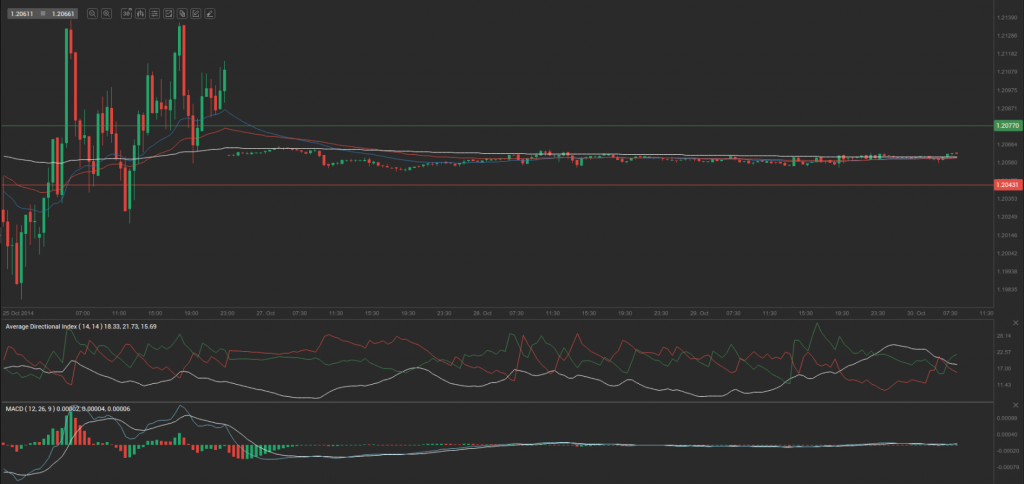Yesterday’s trade saw EUR/CHF within the range of 1.2038-1.2072. The pair closed at 1.2063, unchanged on a daily basis.
At 7:19 GMT today EUR/CHF was up 0.01% for the day to trade at 1.2064. The pair touched a daily high at 1.2065 at 7:20 GMT.
Fundamentals
Euro zone
Spanish Gross Domestic Product – preliminary
The preliminary estimate of Spains annual Gross Domestic Product probably pointed to 1.6% growth in the third quarter of the year, according to the median forecast by experts. In Q2 economy expanded at an annualized pace of 1.2%, according to final data, released on August 28th.
On a quarterly basis, Spanish economy probably expanded 0.5% in Q3, following a 0.6% growth during the second quarter. In Q2 nations GDP was supported by household spending and investment. Household consumption rose at a faster 0.7% rate (0.5% in Q1), while gross fixed capital formation rose 0.5%, following a 0.7% drop in the previous quarter. Spains exports increased 1.3%, after a contraction of 1% in the first quarter.
In case a faster-than-projected rate of growth was reported, this would have a positive effect on the single currency. The preliminary GDP estimate is due out at 8:00 GMT.
Spanish consumer inflation – preliminary estimate
Spain’s preliminary annualized consumer inflation probably rose to 0.1% in October, according to market expectations. In September the final annualized Consumer Price Index (CPI) confirmed the preliminary estimate of -0.2%, with higher housing prices not being enough to neutralize the fall in costs of food and transport. In September downward pressures came from lower prices of transport (-1% year-on-year) and food and non-alcoholic beverages (-0.8% year-on-year), while upward pressures came from housing, water electricity and gas costs (+2.2% year-on-year).
Key categories, included in Spans CPI, are food and non-alcoholic beverages (accounting for 20% of the total weight) and transport (15%). Other categories are real estate (12%), hotels, coffee and restaurants (11.5%), clothing and footwear (9%) and entertainment and culture (7.5%). Health, communication, education and other goods and services comprise the remaining 25% of the index.
The CPI measures the change in price levels of the above mentioned basket of goods and services from consumer’s perspective and also provides clues over purchasing trends. In case the CPI improved more than projected, this would have a bullish effect on the euro. The National Statistics Institute (INE) will release its official report at 8:00 GMT.
Spanish preliminary annualized CPI, evaluated in accordance with Eurostat’s harmonized methodology, probably rose to -0.2% in October from a final estimate of -0.3% in September, as reported on October 14th.
German unemployment
The number of the unemployed people in Germany probably increased by 5 000 in October, according to the median forecast by experts, following an increase by 13 000 during September. The latter has been the sharpest since May. An increase implies that consumer spending may be less active, while the latter is tightly related to economic growth. A decrease suggests the opposite.
At the same time, the seasonally adjusted rate of unemployment in the country probably remained unchanged at 6.7% in October, a rate reported in the past eight months.
In case the number of the unemployed rose more than projected and the unemployment rate increased, this would have a bearish effect on the euro. The Federal Statistics Office will release the official data at 8:55 GMT.
Euro zone Economic Sentiment Indicator
Confidence among consumers in the Euro area probably remained little changed in October. The final value of the consumer confidence index probably confirmed the preliminary estimate of -11.1, which was reported on October 23rd. The final reading for September came in at -11.4. The indicator measures consumer confidence on a scale of -100 to +100. A reading of -100 suggests a lack of confidence, zero means neutrality and a reading of +100 indicates extreme levels of confidence. The index reflects the level of optimism, which consumers have about economic development in the region. The Business and Consumer Survey is conducted by phone and includes 23 000 households in the Euro zone. The questions asked stress on current economic and financial situation, savings intention and also on expected developments regarding consumer price indexes, general economic situation and major purchases of durable goods. This indicator is one of the five major components, that comprise the Economic Sentiment Indicator (ESI).
The ESI probably slipped to 99.7 in October, according to expectations, from a reading of 99.9 in September. If so, this would be the lowest ESI level since November 2013, when the index stood at 98.5. The Economic Sentiment Indicator (ESI) is a composite indicator, consisting of five sectoral confidence indicators with different weights: Industrial confidence indicator, Services confidence indicator, Consumer confidence indicator, Construction confidence indicator, Retail trade confidence indicator. The ESI is calculated as an index with mean value of 100.0 and standard deviation of 10 over a fixed standardised sample period.
Lower confidence usually implies lesser willingness to spend, including large-ticket purchases, while consumer spending is a key factor behind economic growth. Therefore, in case the ESI dropped more than anticipated, this would cause a bearish impact on the euro. The European Commission is expected to release the official reading at 10:00 GMT.
German consumer inflation – preliminary estimate
German preliminary annualized consumer inflation probably accelerated to 0.9% during the current month, according to the median forecast by analysts, from 0.8% in September. The latter has been the lowest level since February 2010. Energy prices dropped at an annualized rate of 2.2% in September. Prices were down in particular for mineral oil products (–5.1%), of which heating oil (–7.9%) and motor fuels (–4.1%). Prices of solid fuels fell 2.0% compared to September last year. Electricity prices, however, rose at an annualized rate of 1.8%. Food prices increased 0.9% compared to September 2013. The cost of services rose above average (+1.5%) compared to September last year, mostly due to the increase in net rents exclusive of heating expenses (+1.4%), on which households spend roughly a fifth of their consumption expenditure, according to the report by Destatis.
The Consumer Price Index (CPI) presents a general picture of the price change in the country, while encompassing all household types, all regions and all goods and services demanded (food, clothing, automobiles, rental, repair and hairdressing services etc). The index is based on a basket of goods and services, which is regularly renewed, so that goods and services, purchased more often by consumers, are included in the present survey.
Nations preliminary annualized CPI, evaluated in accordance with the harmonized methodology, probably also increased to 0.9% in October, after being at 0.8% in July, August and September. This methodology is used for the sake of consumer inflation comparison in an international context (member-countries in the Euro area). In case the CPI exceeded expectations and approached the 2-percent inflation objective, set by the European Central Bank, this would certainly provide support to the euro. Destatis is scheduled to publish the CPI report at 13:00 GMT.
Switzerland
KOF Leading Indicator
The KOF (Konjunkturforschungsstelle) economic barometer in Switzerland probably increased to a reading of 99.4 in October, according to preliminary estimates by experts, from 99.1 in September. It reflects the level of optimism that company executives have about the performance of the economy and how they assess their organizations’ prospects during the following six months. The KOF economic barometer is based on a multi-sectoral design with three modules. The most important module is GDP, which does not include construction and banking sectors, and accounts for 92% of nations total GDP. It is also known as Core GDP. The other two modules are construction and banking. In case of predominant optimism (respectively, an increase in the barometer, especially above expectations), the Swiss franc would receive a boost. The official KOF reading is due out at 8:00 GMT.
Pivot Points
According to Binary Tribune’s daily analysis, the central pivot point for the pair is at 1.2058. In case EUR/CHF manages to breach the first resistance level at 1.2077, it will probably continue up to test 1.2092. In case the second key resistance is broken, the pair will probably attempt to advance to 1.2111.
If EUR/CHF manages to breach the first key support at 1.2043, it will probably continue to slide and test 1.2024. With this second key support broken, the movement to the downside will probably continue to 1.2009.
The mid-Pivot levels for today are as follows: M1 – 1.2017, M2 – 1.2034, M3 – 1.2051, M4 – 1.2068, M5 – 1.2085, M6 – 1.2102.
In weekly terms, the central pivot point is at 1.2060. The three key resistance levels are as follows: R1 – 1.2087, R2 – 1.2112, R3 – 1.2139. The three key support levels are: S1 – 1.2035, S2 – 1.2008, S3 – 1.2000.






